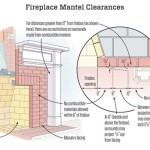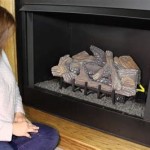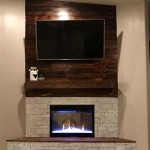Wood Fireplace Screens: Functionality, Aesthetics, and Safety
Wood fireplace screens serve as essential components for both the safe and aesthetically pleasing operation of a traditional wood-burning fireplace. Their primary function is to contain sparks and embers, preventing them from escaping the firebox and potentially causing damage to the surrounding environment or posing a fire hazard. Beyond this critical safety role, fireplace screens also contribute significantly to the overall decorative appeal of the hearth, acting as a visual focal point and complementing the existing décor of the room.
The selection of a suitable fireplace screen involves careful consideration of several factors, including the size and shape of the fireplace opening, the desired style and aesthetic, and the materials used in construction. A properly chosen screen will not only provide essential protection but will also enhance the visual appeal of the fireplace and contribute to a comfortable and inviting atmosphere.
Safety and Fire Protection
The primary and most critical function of a wood fireplace screen is to prevent sparks and embers from escaping the firebox. Burning wood naturally produces small, hot particles that can be projected outwards by the natural drafts and occasional popping or cracking within the fire. These embers, if allowed to land on carpets, furniture, or other combustible materials, can readily ignite, causing significant damage and presenting a serious fire risk. A well-constructed fireplace screen effectively contains these sparks, significantly reducing the likelihood of accidental fires.
The mesh material used in the screen is crucial for effective spark containment. Closely woven wire mesh, typically made of steel or iron, is ideal for preventing even the smallest embers from passing through. The size of the mesh openings is a critical consideration; smaller openings provide better protection, but can also potentially restrict airflow to the fire, impacting its combustion efficiency. A balance must be struck between effective spark containment and maintaining adequate ventilation for the fire to burn properly.
Beyond spark containment, fireplace screens also provide a barrier that helps to prevent accidental contact with the open flames. This is particularly important in households with children or pets, where the risk of accidental burns is increased. The screen acts as a physical deterrent, preventing individuals from getting too close to the fire and potentially suffering injury.
In addition to protecting the immediate surroundings of the fireplace, a screen can also help to prevent drafts from blowing embers out of the firebox. Drafts can create unpredictable air currents that can carry embers further into the room, increasing the risk of fire. The screen effectively blocks these drafts, maintaining a more stable and contained fire environment.
Aesthetic Considerations and Design Styles
Beyond their practical function, fireplace screens offer a significant opportunity to enhance the aesthetic appeal of the hearth. They are available in a wide variety of styles, materials, and finishes, allowing homeowners to select a screen that complements the existing décor of the room and reflects their personal taste. The screen can serve as a focal point, drawing attention to the fireplace and creating a visually appealing centerpiece for the room.
One common style of fireplace screen is the single-panel screen. This type of screen consists of a single rectangular or arched panel that is placed directly in front of the fireplace opening. Single-panel screens are often simple and understated in design, making them a versatile choice that can complement a variety of décor styles. They are also relatively easy to install and maintain.
Another popular style is the three-panel screen. These screens consist of a central panel flanked by two smaller side panels. The side panels can be angled to provide a more custom fit to the fireplace opening and to enhance the visual appeal of the screen. Three-panel screens are often more ornate in design than single-panel screens, featuring decorative details such as scrollwork, floral motifs, or geometric patterns.
For larger fireplaces, a four-panel screen may be the most appropriate choice. These screens offer greater coverage and stability, particularly for wide fireplace openings. Four-panel screens are often designed with a combination of solid panels and mesh panels, allowing for both visual appeal and effective spark containment.
The materials used in the construction of the fireplace screen also contribute significantly to its aesthetic appeal. Common materials include steel, iron, brass, and copper. Steel screens are typically durable and affordable, while iron screens offer a more rustic and traditional look. Brass and copper screens add a touch of elegance and sophistication to the hearth.
The finish of the screen is another important consideration. Common finishes include black, bronze, silver, and gold. Black finishes are often used for a more contemporary or minimalist look, while bronze finishes provide a warmer and more traditional feel. Silver and gold finishes add a touch of glamour and elegance to the fireplace.
Materials and Construction
The materials used in the construction of a wood fireplace screen significantly impact its durability, functionality, and aesthetic appeal. The frame of the screen is typically made of metal, such as steel, iron, brass, or copper. The mesh material, which is responsible for spark containment, is usually made of steel or iron wire.
Steel screens are known for their durability and affordability. They are resistant to rust and corrosion, making them a good choice for long-term use. Steel screens are also relatively easy to clean and maintain. However, steel may not be as visually appealing as some other materials, and it may require painting or powder coating to achieve the desired finish.
Iron screens offer a more rustic and traditional look. Iron is a strong and durable material that can withstand high temperatures. Iron screens are often more ornate in design than steel screens, featuring decorative details such as scrollwork or floral motifs. However, iron is more susceptible to rust than steel and may require regular maintenance to prevent corrosion.
Brass and copper screens add a touch of elegance and sophistication to the hearth. These materials are known for their warm and rich colors. Brass and copper screens are often more expensive than steel or iron screens, but they can significantly enhance the visual appeal of the fireplace. However, brass and copper are relatively soft metals and may be more susceptible to dents and scratches than steel or iron.
The construction of the fireplace screen is also important for its overall quality and durability. The frame should be sturdy and well-built, with strong joints that can withstand the weight of the screen and the stresses of regular use. The mesh should be securely attached to the frame, with no gaps or loose wires that could allow sparks to escape.
The hinges and latches on the screen should also be of high quality. The hinges should allow the screen to open and close smoothly, and the latches should securely hold the screen in place. The handles on the screen should be comfortable to grip and easy to use.
Furthermore, some screens incorporate features like sliding doors within the mesh. These can be useful for adding wood without having to move the entire screen. The quality of the sliding mechanism is a key consideration for ease of use and longevity.
The choice of materials and construction techniques ultimately depends on the desired aesthetic, budget, and level of durability required. A well-constructed screen made of quality materials will provide years of reliable service and enhance the beauty of the fireplace.
Ultimately, the selection of a wood fireplace screen involves balancing safety considerations with aesthetic preferences. By carefully considering the size and shape of the fireplace opening, the desired style and materials, and the quality of construction, homeowners can choose a screen that not only provides essential protection but also enhances the visual appeal of the hearth and contributes to a warm and inviting atmosphere.

Best Fireplace Screens Top 6 Reviews Comparisons

Mountain Cabin Fire Screen With Door Plow Hearth

Chesneys Usa Are Fireplace Screens Necessary

5 Favorites Simple Fire Screens Remodelista

View All Fireplace Screens Pilgrim Home Hearth

Bowed Fireplace Screen Rejuvenation

Fireplace Glass Doors Vs Screens Full Service Chimney

Ping For Fire Screens The New York Times

Flat Fireplace Screen Rejuvenation

Fireplace Mesh Valance Screens
Related Posts








